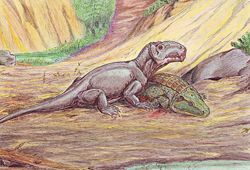| Brithopus Temporal range: Middle Permian, Ufimian | |
|---|---|
 | |
| Life restoration of Brithopus feeding on a temnospondyl | |
| Scientific classification | |
| Kingdom: | Animalia |
| Phylum: | Chordata |
| Clade: | Synapsida |
| Clade: | Therapsida |
| Suborder: | † Dinocephalia |
| Family: | † Brithopodidae |
| Genus: | † Brithopus Kutorga, 1838 |
| Species: | †B. priscus |
| Binomial name | |
| †Brithopus priscus Kutorga, 1838 | |
| Synonyms | |
| |
Brithopus is an extinct genus of dinocephalian therapsids. It contains a single species, Brithopus priscus, known from fragmentary remains found in the Copper Sandstones near Isheevo, Russia.


